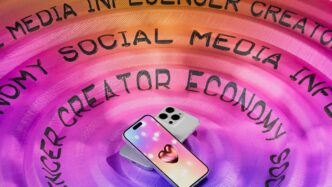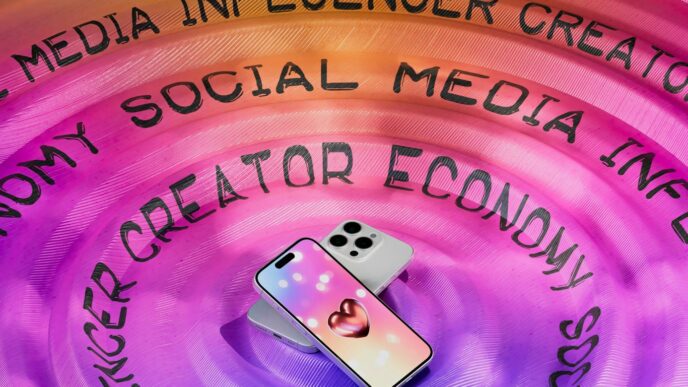Content innovation is changing fast, and 2025 is shaping up to be a year where brands can’t just rely on the same old tricks. People expect more—more relevance, more interaction, and more honesty. If you’re not keeping up, you’re probably losing attention (and sales) to someone who is. This article covers practical ways to keep your content fresh, connect with your audience, and actually make a difference in how people see your brand. Whether you’re working solo or part of a big marketing team, these strategies can help you stand out and keep your audience coming back.
Key Takeaways
- Using data helps you understand what people want and lets you make content that actually matters to them.
- Mixing AI with real people’s ideas can speed up content creation without making it feel fake.
- Interactive stuff—like AR, VR, and live videos—gets people to take part, not just watch.
- Letting customers share their stories and feedback makes your brand feel more real and trustworthy.
- Personalized content, sent through the right channels, keeps people interested and loyal.
Harnessing Data-Driven Content Innovation for Deeper Audience Insights
The way content marketers work keeps shifting, especially now that every audience is bombarded with choices. If you’re not using data to shape your content, you’re probably missing out. In 2025, data isn’t just a nice-to-have, it’s what sets average content apart from stuff people actually read and remember. Here’s how you can tap into the real power of data to get closer to your audience—without getting lost in the numbers.
Leveraging Predictive Analytics for Trend Identification
Sometimes it feels like everyone is playing catch-up with the latest trends, but if you’re serious about standing out, you have to get ahead of them. Predictive analytics makes that possible. These tools review search patterns, social buzz, and even buying habits to spot what’s about to grab people’s attention—not just what was hot yesterday. By doing this, you can:
- Pinpoint emerging subjects before they flood your industry.
- Write content that answers tomorrow’s questions.
- Fine-tune your editorial calendar based on real patterns, not just gut feelings.
A quick snapshot of where predictive analytics really shines:
| Area | Example Use | Benefit |
|---|---|---|
| Topic Discovery | Trend spotting | Get ahead of the competition |
| SEO Planning | Search term shifts | Improve rankings early |
| Content Scheduling | Seasonality prediction | Timely campaign delivery |
If you want the full scoop on this year’s biggest moves, these content marketing trends for 2025 break down what’s changing and what’s still working.
Personalizing Content Through Behavioral Data
Personalization isn’t some fancy add-on; it’s basic now. Everyone expects content to speak directly to them, not just a generic crowd. Behavioral data (looking at how people act, not just what they say) helps you do exactly that. Here’s what strong content personalization looks like:
- Use browsing and purchase behavior to sort your audience into focused groups.
- Create targeted content for each group. For example, new visitors get beginner guides, repeat buyers see comparison lists.
- Adjust your content as people’s actions change—automatically if you can.
You’ll notice bounce rates go down and time on page goes up when people feel seen.
Measuring Engagement with Real-Time Metrics
Real-time metrics finally let you stop guessing if things are working. Tracking things like click rates, scroll depth, and even live feedback means you can tweak your content while it’s still fresh, not months later. Here’s what to track, at a minimum:
- Click-through rate (CTR)
- Scroll depth (How far do users get, really?)
- Shares, comments, saves—anything that shows genuine reaction
- Repeat visits
These numbers aren’t just for bragging. They help you see what resonates—so you can double down on what your audience actually enjoys, not just what you hope they will.
Blending data-driven moves with some honest creative work is what’s making content marketing way more effective this year. If you’re serious about pushing your brand forward, it’s time to let data guide the way… just don’t forget the human side too.
Blending Human Creativity With Artificial Intelligence in Content Creation
Blending human creativity with artificial intelligence is more than a trend; it’s now part of every content team’s reality. By teaming up human ideas with machine learning, brands are finding fresh ways to make their content stand out. Sometimes it’s messy, sometimes it’s magical, but the mix really works. If you want examples of how people are combining their instincts with AI, check out thoughts on hybrid creativity in marketing.
Sparking Unique Ideas With AI Assistance
Let’s get real—sometimes brainstorming just stalls, especially on deadline weeks. AI’s not a magic bullet, but it can:
- Suggest uncommon headlines when you’re out of inspiration
- Find angles in data you never considered
- Help gather background research in half the time you’d need on your own
Writers are still steering the wheel, but having an algorithm throw new options into the mix can keep the work fresh. It’s a way to break routines and spot gaps in what competitors are publishing.
Enhancing Creative Workflows Without Losing Authenticity
The risk with letting AI do too much? Your voice gets lost. People want to read stuff that feels personal, not robotic. Here’s how teams are keeping things authentic:
- Use AI for tedious tasks like grammar or spelling checks, freeing up time for actual writing.
- Fact-check everything AI generates—machines can get stuff wrong, and your viewers will notice.
- Let human editors do the final tweaks so the story still feels honest and relatable.
Being up-front about when AI is in the mix can boost trust. Readers appreciate when brands are honest about their workflow.
AI-Driven A/B Testing for Content Optimization
Getting creative with content isn’t just about what you say—but how people react. AI-powered A/B testing lets you try out new formats, headlines, or images, then quickly adjust when you see what works best. Here’s a sample of what teams could compare:
| Version | Headline Style | Average Engagement (%) |
|---|---|---|
| A | Playful/Conversational | 43 |
| B | Formal/Informative | 31 |
Benefits of using AI in this area:
- Tests dozens of versions at once, not just two
- Optimizes faster as it learns what segments prefer
- Shifts more views to best performers automatically
If you’re not experimenting, you’re probably missing out on a style that could work better for your audience. The key is to let data guide your next move, while still putting your brand’s personality front and center.
Cultivating Engagement With Interactive and Immersive Content Experiences
Interactive and immersive content isn’t just a buzzword for 2025—it’s how brands are actually connecting with people when old-school, static content falls flat. If users feel included and can play a part in the experience, they’re way more likely to stick around and remember your brand. Let’s break down the most practical, current ways companies are doing this:
Implementing AR and VR for Dynamic Brand Storytelling
Not too long ago, augmented reality (AR) and virtual reality (VR) sounded expensive and complicated. Now, you can try on glasses through your phone or take a virtual tour of an apartment from your laptop. What’s the trick? Give people a reason to explore, not just scroll by.
- AR lets shoppers see how furniture looks in their living room before they buy
- VR tours offer an inside look at vacation destinations, campuses, or event spaces
- Brands are using AR filters for social media challenges, inspiring users to create and share branded content
Companies are seeing results here, too. According to IKEA’s reports, customers who used their AR app spent, on average, 11% more time considering purchases than those who didn’t. These little moments of interaction build curiosity and connection.
Designing Interactive Content to Encourage Participation
Passive content is out. Interactive formats—like quizzes, polls, smart calculators, and choose-your-own-adventure stories—keep visitors coming back. Something as simple as a pricing calculator or personality quiz feels personal right away. These aren’t just for fun; they can offer practical value while boosting time-on-site and data collection.
Here’s a quick list of interactive content ideas that work for almost any brand:
- Quizzes that provide personalized recommendations or feedback
- Polls that let users feel heard (and spark discussion)
- Calculators that show custom estimates—think insurance, loans, or carbon footprint
Done right, interactive content enhances user experience by providing choices and personalized paths that make every interaction count.
Integrating Shoppable Videos and Live Streaming
Shopping isn’t always about the product—it’s about the experience. Livestream shopping events and videos where you can click to buy what you see give users something more than static ads: instant, hands-on paths to purchase.
| Format | Engagement Rate* | Conversion Rate* |
|---|---|---|
| Shoppable Video | 24% | 7% |
| Livestream Shopping | 31% | 11% |
| Static Product Video | 12% | 3% |
*2025 industry averages based on recent surveys.
A few ways brands are making this work:
- Hosting Q&A sessions with product experts or influencers
- Including real-time polls during livestreams to steer conversation
- Letting viewers click on video products to add items to carts instantly
Interactive, immersive content is more than a trend. As technology gets easier for everyone, it’s the brands making content feel alive—and truly two-way—that people will remember long after the session ends.
Building Trust and Authenticity Through User-Generated Content
Connecting with audiences isn’t about clever headlines or the latest viral trend. The real magic happens when users bring their own stories to the table. User-generated content (UGC) gives brands something money can’t buy: genuine word-of-mouth and real-life experiences. When actual customers post reviews or share their story, people are far more likely to believe it over a polished ad campaign.
Encouraging Community Contributions for Genuine Narratives
Instead of pushing your own message, let your customers do some of the talking. Here’s what usually works:
- Set up easy ways for folks to share their stories—think hashtags, prompts, or quick submission forms.
- Highlight the people behind the posts (real names and photos make it feel less staged).
- Make it clear you appreciate all types of stories, not just picture-perfect testimonials.
If you want to see just how effective UGC can be for marketing, you might want to check out these user-generated content statistics.
Showcasing Customer Stories for Relatability
People like to see themselves reflected in a brand’s story. Give customer experiences center stage:
- Feature reviews and testimonials on landing pages and in email newsletters.
- Create a regular blog or video series spotlighting customers and their journeys.
- Let customers explain what drew them in—and don’t edit out the bumps in the road. The honest stuff sticks.
Here’s a super brief table to show the difference in trust:
| Source | Trust Level (2025 Survey*) |
|---|---|
| Brand-created ad | 23% |
| UGC/Testimonial | 68% |
*Survey of 1,000 online shoppers, January 2025
Curating and Highlighting Brand-Aligned UGC
UGC isn’t always a perfect fit. That’s alright. Curation is part of the job. Look for submissions that:
- Match your brand’s tone but still feel real.
- Tell a complete or specific story.
- Show your product or service in realistic situations (not staged or over-the-top).
A few quick pointers:
- Regularly review and refresh the featured content.
- Get consent and give credit—always.
- Respond or comment when users share good stuff. It keeps the conversation alive.
When you let customers become part of your marketing, you’re showing them you care about their voice. That’s how trust starts—and sticks.
Elevating Personalization With Advanced Content Segmentation

Personalization in 2025 looks a lot different than it did a few years back. It’s no longer just about using someone’s name in an email. Brands now use real-time data, automation tools, and thoughtful segmentation to speak directly to what someone wants—almost before they even know it themselves. Let’s unpack how teams are making it work.
Segmenting Audiences Based on Real-Time Behavior
People don’t fit into neat boxes. That’s why breaking up your audience by just age or gender isn’t cutting it. Now, companies look at what people actually do—their clicks, page visits, purchases, and even things like how often they check your site.
- Update audience lists constantly using live data, not just old stats.
- Set up triggers: For example, if someone spends a lot of time on a certain product, send them a promo for it.
- Watch for patterns around holidays or events and adjust your messages to fit when interest spikes.
Here’s how some brands are handling it, in quick bullet points:
- Behaviors: like abandoned carts or frequent returns.
- Preferences: specific categories shopped most.
- Timing: certain hours of browsing, or regular purchase cycles.
If you want fresh ideas for where to start, thinking about your social media presence can be a good first step. People’s activity and engagement patterns there can spark surprising insights for your core segments.
Delivering Dynamic Web Experiences
Static, one-size-fits-all sites are fading out. Now, people expect websites to change based on what they like, or even what they just browsed a moment ago. This isn’t just a fancy add-on; it drives more clicks and conversions.
- Sites can swap out banners, recommendations, or even chatbots—depending on the user.
- Pop-ups are smarter: only showing to certain groups, at the right moment.
- Custom landing pages greet returning users with fresh content tailored to their interests.
Here’s a simplified table with a few common dynamic web elements and the kind of impact they can have:
| Feature | Personalization Example | Typical Impact |
|---|---|---|
| Recommended Products | Based on last 3 purchases | Higher conversion rate |
| Personalized Pop-ups | Special birthday offers | Better engagement |
| Adaptive Content Blocks | Swap blog topics by interest | Lower bounce rate |
Optimizing Email Personalization Strategies
Email is alive and well—but now it’s way more tailored. Teams use all the behavior and preference info they can get to decide who gets what, and when.
Consider these steps:
- Set up automation to send emails based on actions: like welcoming a new sign-up, or reminding someone about a forgotten cart.
- Use predictive data to suggest products or send coupons, depending on where customers are in their journey.
- Test, tweak, and adjust: A/B tests let you see what works (subject lines, times to send, images, etc.).
Brands who really stick with it often notice more opens, more clicks, and more loyal customers sticking around. Segmentation and personalization work together—each audience gets what they want, and you see the benefits back.
Driving Loyalty and Retention With Purpose-Driven Content Innovation

Building loyalty today isn’t about pushing endless product features or flashy deals. It means standing for something. When you create content that reflects your brand’s values and gets people to care, loyalty follows. Let’s walk through how purpose-driven content can hang onto customers and keep them coming back.
Aligning Brand Content With Social Responsibility Initiatives
It’s no secret that people want the brands they support to actually care about the world. That’s why linking your content to causes or initiatives can be powerful.
- Share updates about environmental efforts, like switching to recyclable materials.
- Promote employee volunteer projects or local community support.
- Clearly connect these efforts to your brand story, so it feels real—no greenwashing.
Social Responsibility Content Ideas Table
| Initiative Type | Example Content |
|---|---|
| Sustainability Updates | Monthly blog on carbon savings |
| Community Involvement | Video: staff volunteering |
| Ethical Sourcing | Instagram story: supply chain tour |
Transparency and follow-ups matter; if you announce a new project, show progress over time. That builds trust and keeps people interested.
Demonstrating Transparency in Content Practices
Customers are quick to spot half-truths. Gaining their trust now requires content that’s upfront about your methods, product sources, and mistakes.
Here’s how you can be clear—and why it matters:
- Explain sourcing: "Here’s where this T-shirt cotton really comes from."
- Share the metrics: Show how much waste your new initiative has already cut.
- Own your misses: If a campaign flopped, or you missed a target, say so. People respect honesty.
Don’t just say what you’re doing—show it. Regular updates and detailed, plain-language reports can make your brand look a whole lot more human.
Fostering Emotional Connections With Values-Driven Storytelling
The old sales pitch is fading. Instead, stories about real people, struggles, or positive change feel real. Emotional content gets reactions and keeps brands at the top of mind.
- Highlight stories from staff or customers who share your values.
- Document the real impact your initiative has made, in detail—think short documentaries instead of ads.
- Invite your audience to share their own experiences and values. Use those voices in your newsletter or main site.
An emotional connection means people remember you—not because your product is cheap or flashy, but because your values align. When your content consistently reflects what you stand for, loyalty and retention aren’t luck. They’re built into your brand.
Maximizing Reach and Consistency With Omnichannel Content Strategies
It’s 2025 and people want to interact with brands wherever, whenever, and however they feel like it. Being present on every platform is good, but having a clear, steady message across all of them is what actually gets attention and keeps people coming back. Here’s how brands are making it work:
Synchronizing Content Across All Digital Platforms
If you post on Instagram, send emails, and update your website, but everything feels a bit like it’s written by different people, there’s work to do. Customers notice these things. To keep it all running smoothly:
- Make a schedule: Know when and where each piece of content is going live.
- Use templates: A set color scheme, logo, and a few taglines make things feel unified.
- Share data between platforms: If someone clicks your email and later visits your site, keep their experience connected.
Example of Content Release Schedule:
| Platform | Monday | Wednesday | Friday |
|---|---|---|---|
| New post | Story Q&A | Product teasers | |
| Newsletter | – | Promo | |
| Website | Blog update | Feature page | Flash sale |
Ensuring a Unified Brand Voice
Your brand voice is more than the words you put out—it’s the way you talk to people and how you make them feel. Here’s what steady brand voice looks like:
- Write a simple guide for your tone (friendly? serious? playful?).
- Share the guide with everyone creating content—not just marketing folks.
- Review posts before they go up to spot anything weird or off-message.
Utilizing Multi-Touchpoint Journeys for Greater Impact
Nobody takes a straight path from discovering your brand to deciding they like you. Omnichannel means every interaction builds on the last. To use this to your advantage:
- Track where your visitors first interact and where they end up (came in from TikTok but buys through email).
- Remind people about their journey when possible (if they left something in their online cart, send a gentle nudge).
- Make sure offers, messages, and visuals are in sync no matter the platform.
People will trust a brand more when their entire experience—start to finish—feels intentional and connected, not random or cobbled together. The trick isn’t to be everywhere. It’s to make everywhere feel unmistakably like you.
Conclusion
So, that’s the lay of the land for content innovation in 2025. It’s a lot to keep up with, honestly. Audiences are getting pickier, and there’s more noise than ever. But if you focus on making content that feels real, uses tech in smart ways, and actually listens to what people want, you’re already ahead of the pack. Try out new ideas, see what sticks, and don’t be afraid to change things up if something isn’t working. At the end of the day, it’s about building trust and keeping folks interested—not just chasing the next big thing. If you keep your audience at the center, you’ll find ways to stand out and keep them coming back, no matter how the trends shift.
Frequently Asked Questions
What does content innovation mean for brands in 2025?
Content innovation in 2025 means using new ideas, tools, and technology to make content that grabs attention and keeps people interested. Brands use data, AI, and creative ways to tell stories, so their messages stand out and connect with people.
How can using data help create better content?
By looking at data, brands can learn what their audience likes, what topics are popular, and when people are most active online. This helps them make content that matches what people want, making it more likely to be seen and shared.
Why is mixing human creativity and AI important in content creation?
AI can help with ideas and make work faster, but human creativity adds feelings and a personal touch. When brands use both, they can make content that feels real and interesting, while also being smart and efficient.
What are interactive and immersive content experiences?
Interactive content lets people take part, like answering quizzes or exploring videos. Immersive content uses things like AR or VR to make people feel like they are part of the story. Both types help keep people interested and make them remember the brand.
How does user-generated content build trust?
User-generated content is made by real customers, not the brand. When people see others sharing their honest experiences, it feels more trustworthy and real. Brands can use these stories to show they care about their community.
What is omnichannel content, and why does it matter?
Omnichannel content means sharing the same message and style across all platforms, like websites, social media, and emails. This helps people recognize the brand wherever they see it and makes their experience smoother and more reliable.














